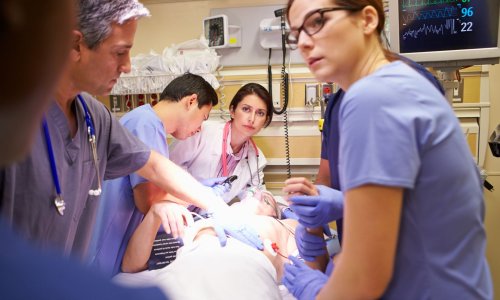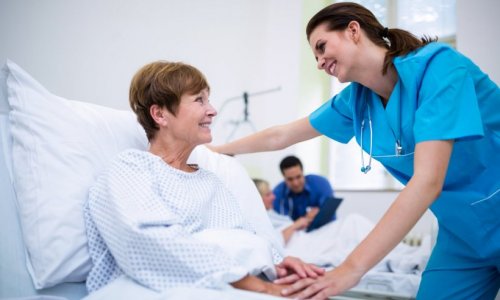Terror attacks in Madrid
by Eduardo de la Sota
The 11/3/04 attacks consisted of a series of ten explosions aboard four commuter trains, during the height of the Madrid rush hour.

Thirteen improvised explosive devices were reported to have been used, three did not detonate. The definite death toll was 191, and over 2,000 people were injured.
Immediately following these attacks, the emergency services began work. The Madrid Metro and Atocha Station were closed to citizens. At first the wounded were treated in field hospitals put to use in areas around the explosions sites.
Initially, the injured were then transferred in ambulances, buses, police cars and private vehicles to the main hospitals of Madrid (Gregorio Marañón (GMUGH), 12 October, La Paz and La Princesa) which, according to the Emergency Plan coordinated by the ‘112’ emergency service, also evacuated the slightly injured to their homes, to avoid a collapse in medical services.
The citizens responded excellently to calls for blood donations from the health services. By late morning donations were no longer necessary, despite unceasing activity in all Madrid’s hospitals. The dead were taken to Pavilion Six of IFEMA (one of Madrid’s Trade Fair sites), where forensic surgeons identified corpses.
Medical management
Doctors from the Gregorio Marañon University General Hospital analysed the results of medical management of 312 survivors triaged to the GMUGH. Results confirmed the many consistent patterns to be expected following terrorist bombings, which virtually every other published series has documented. The great majority of immediate survivors (95%), were not critically injured. As the authors state, this is best explained by the selection bias caused by the immediate death of most of those with critical injuries. Although it appears quite favourable that 14 of these 1,885 immediate survivors (0.74%) subsequently died, it is important to recognise that this is deceptive, because most casualties were not at all at risk of death. The death rate was correctly expressed in this report as a percentage of only the critically injured casualties, who were truly at risk for death, and among whom all deaths occurred, resulting in a much heftier ‘critical mortality’ rate of 17% (14/82). This is a more accurate reflection of the quality of medical care given in such a mass casualty setting, and is a more accurate standard for comparison with other, similar bombings.
At the GMUGH, 91 of the 312 survivors evaluated (29%) were hospitalised, but 62 of these were not critically injured, yielding a substantial over-triage rate of 68%.
The danger with this degree of over-triage is in the potential to overwhelm limited medical resources and prevent that minority with critical injuries from being quickly identified and treated, thus increasing critical mortality. Although the authors did not believe that this interfered with their treatment, their 17.2% critical mortality at this level of over-triage falls well within the linear relationship demonstrated between over-triage and critical mortality.
They wrote, ‘…the bombings occurred shortly before the start of a midweek workday when most clinicians and medical personnel were on their way to work or already in hospital, and night shifts were still on duty. This, together with empty operating rooms and personnel waiting for the first scheduled cases, proved decisive for the adequacy of the medical and surgical response at GMUGH and other hospitals. Had the blasts occurred just one hour later, the whole situation would have been much worse and very difficult to handle.’
Eric R Frykberg, Professor of Surgery at the University of Florida College of Medicine and the author of a number of articles related to this subject, endorses their findings in his commentary, also published in Critical Care. He emphasises: ‘… preventing as much as possible the arrival of so many non-critical victims to a definitive care hospital by performing triage first at outside sites before allowing them to inundate the hospital.’
The authors conclude: ‘All in all, common sense, diligence in the triage of patients and serenity seemed to prevail after the initial unavoidable chaos and emotional trauma common to these situations. There was in fact an abundance of medical teams, nursing staff, and resources to treat the critically injured, and no critically injured patient had a delay in treatment.’
Mobilised emergency resources
According to the Community of Madrid Regional Government, the number of people and resources mobilised (excluding the national police) were:
Psychological care for victims
Just a few hours after the terrorist attacks, the psychological care services for victims and their relatives went into operation. These services consisted of direct interventions among the affected people – mainly in IFEMA and the hospitals – and telephone attendance coordinated with the 112 emergency services. The Official College of Psychologists of Madrid 20 coordinated these services. Also, after the attacks, the Region of Madrid decided to organise a special psychological care service by engaging new staff for 18 months, to take care of additional needs.
11 M. Economic Costs
The results of the evaluation of the economic costs that can be attributed to the 11 March attacks are shown in table II. This evaluation was made by the application of conservative criteria to avoid any exaggeration in the numbers obtained. Therefore, these quantities should be considered as the minimum direct cost that the attacks incurred for the Madrilenian economy. Studies of the incidence of terrorism on the economy of countries or the regions in which those actions happened emphasise that, generally, even when such attacks are of great significance, the damages caused usually have a limited effect, only if they are considered individually and the terrorist threat is not persistent over time. Terrorism is a war of low intensity that produces a certain weakening of the economy in societies where they took place. This weakening only becomes significant when such attacks persist over time. This hypothesis is confirmed by data collected in this work, which confirm that the direct influence of the attacksof 11 March, in Madrid, has been limited. Furthermore, the effectiveness of the police and legal control has contributed decisively to the lack of the terrorist persistence.
The total amount turns out to be over 211.58 million euros. 63.4% of this number corresponds to the loss of 191 human lives and to injuries caused to almost 1,600 people directly affected by the attacks. Damages have been evaluated based on the compensation that victims are eligible to receive. A second important concept is the amount caused by the expression of the solidarity of society with those affected by such attacks. More than a quarter of the total cost considered by this study is related to the demonstration of 12/3/04. In third and fourth place, with an equivalent value around 2.5% are damages caused in railway infrastructures and housing, as well as the health cost of victim care.
14.11.2006







